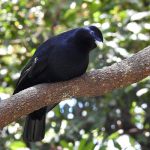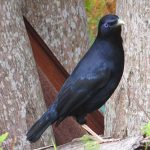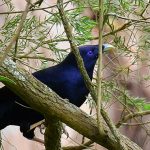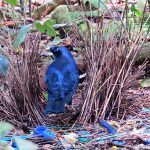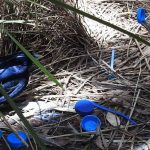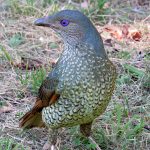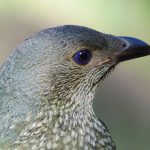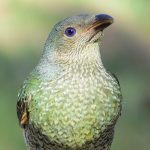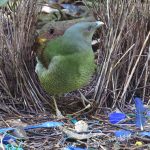SATIN BOWERBIRD
The Satin bowerbird is a species of bowerbird native to eastern Australia. Bowerbirds are known for their unique courtship behavior, where males build intricate and elaborately decorated structures called bowers to attract females.
Male Satin bowerbirds are striking in appearance with their glossy blue-black plumage, which gives them the “satin” name. They have a striking violet-blue eye color and a pale, almost white iris. Females, on the other hand, have more subdued colors, with mostly olive-brown plumage.
The Satin bowerbird is renowned for its bower-building skills. Unlike nests used for raising young, the bower is a display structure used in courtship rituals. The male constructs the bower out of twigs and grass, forming two parallel walls, and then decorates it with various colorful objects, such as flowers, feathers, berries, and even man-made items like bottle caps, pieces of plastic, or colorful paper. The decorations are meticulously arranged to attract female attention.
To attract females, the male satin bowerbird performs elaborate courtship displays around the bower. He dances and vocalizes while showing off the bower and the collected decorations. The female will visit multiple bowers and observe the displays before making her choice of a mate.
The Satin bowerbird’s diet primarily consists of fruits, nectar, insects, and some plant matter. They have a varied diet and play a role in seed dispersal in their ecosystem.
The Satin bowerbird is found in the rainforests, wet sclerophyll forests, and adjacent wooded habitats along the eastern coast of Australia, from northern Queensland to south-eastern New South Wales.
Habitat destruction and fragmentation as well as predation by introduced foxes, dogs and cats pose localized threats to their populations.
Satin bowerbirds are fascinating creatures known for their unique behaviors and colorful courtship rituals. Their elaborate bowers and the effort they put into decorating them make them one of the most captivating species among the avian world.


